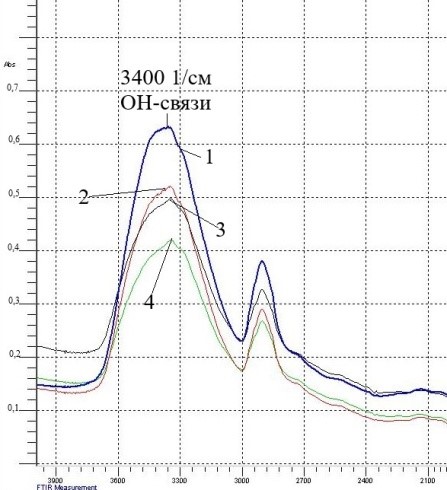STUDY OF THE ADSORPTION PROPERTIES OF PLANT CELLULOSE WITH RESPECT TO NICKEL IONS
UDC 66.081:546.74
DOI:
https://doi.org/10.14258/jcprm.2020026573Keywords:
cellulose, beet pulp, adsorption, desorption, heavy metals, cleaningAbstract
In this paper, we studied the sorption properties of cellulose isolated from sugar beet pulp in relation to Ni2+. Plant cellulose from sugar beet pulp was isolated by successive acid and alkaline extraction, the effectiveness of which was evaluated by infrared spectroscopy. The sorption test showed that cellulose extracted from sugar beet pulp sorbed the main amount of Ni2+ within 1 hour. The maximum sorption capacity of cellulose from beet pulp pulp was 5.01 mmol Nh2+ per 1 kg of dry cellulose from pulp beet pulp. The amount of sorbed Ni2+ depended on the initial Ni2+ concentration in the solution. The most effective recovery of Ni2+ occurred from solutions with a Ni2+ concentration no more than 23.17 μmol/l, allowing to achieve a degree of recovery of this heavy metal of 67.9%. An increase in the initial concentration of Ni2+ in the solution resulted in a reduction in the degree of recovery of this element to 18.6%, which indicates the feasibility of using cellulose from sugar beet pulp for purification of water contaminated with nickel compounds in low concentrations. Comparison of the efficiency of Ni2+ sorption at different pH values showed that this process is pH dependent and the amount of sorbed Ni2+ and the degree of recovery of Ni2+ by cellulose from sugar beet pulp increased with increasing of pH values from 3.0 to 7.0.
Downloads
References
2. Wuana R.A., Okieimen F.E. ISRN Ecology, 2011, vol. 2011, pp. 1–20. DOI:10.5402/2011/402647.
3. Arora S., Jain C.K., Lokhande R.S. International Journal of Environmental Sciences & Natural Resources, 2017, vol. 3, no. 5, pp. 001–006. DOI: 10.19080/IJESNR.2017.03.555625.
4. Menné T. Science of The Total Environment, 1994, vol. 148, no. 2–3, pp. 275–281.
5. Shen H.M., Zhang Q.F. Environ Health Perspect, 1994, vol. 102, no. 1, pp. 275–282. DOI: 10.1289/ehp.94102s1275.
6. Canaz E., Kilinc M., Sayar H., Kiran G., Ozyureke E. Journal of Trace Elements in Medicine and Biology, 2017, vol. 43, pp. 217–223. DOI: 10.1016/j.jtemb.2017.05.003.
7. Zambelli B., Uversky V.N., Ciurli S. Biochimica et Biophysica Acta (BBA) – Proteins and Proteomics, 2016, vol. 1864, no. 12, pp. 1714–1731. DOI: 10.1016/j.bbapap.2016.09.008.
8. Forgacs Z., Massányi P., Lukac N., Somosy Z. J. Environ Sci Health A Tox Hazard Subst Environ Eng., 2012, vol. 47, no. 9, pp. 1249–1260. DOI: 10.1080/10934529.2012.672114.
9. Apostoli P., Catalani S. Met Ions Life Sci., 2011, vol. 8, pp. 263–303. DOI: 10.1039/9781849732116-00263.
10. Barragán-Peña P., Macedo-Miranda M.G. Open Access Journal of Toxicology, 2018, vol. 3, no. 1, pp. 001–003. DOI: 10.19080/OAJT.2018.03.555602.
11. Radjenovic A., Malina J., Štrkalj A. The Holistic Approach to Environment, 2011, vol. 1, no. 3, pp. 109–120.
12. Ortiz N.M., Pires M.A.F., Bressian J.C. Waste management, 2001, vol. 21, pp. 631–635. DOI: 10.1016/S0956-053X(00)00123-9.
13. Тyler G., Balsberg Pahlsson A.-M., Bengtsson G., Baath E., Tranvik L. Water Air Soil Pollute, 1989, vol. 47, no. 3–4, pp. 189–215.
14. Nikiforova T.E., Kozlov V.A. Russian Journal of Applied Chemistry, 2010, vol. 83, no. 10, pp. 1781−1784. DOI: 10.1134/S1070427210100095.
15. Chauhan S. Journal of Chemical and Pharmaceutical Research, 2016, vol. 8, no. 4, pp. 416–420.
16. Krishna R.H., Gilbert W.B. International Journal of Advanced Chemistry, 2014, vol. 2, no. 1, pp. 1–5. DOI: 10.14419/ijac.v2i1.1531.
17. Anastopoulos I., Bhatnagar A., Hameed B.H., Ok Y.S., Omirou M. Journal of Molecular Liquids, 2017, vol. 240, pp. 179–188. DOI: 10.1016/j.molliq.2017.05.063.
18. Kumar R., Sharma R.Kr., Singh A.P. Journal of Molecular Liquids, 2017, vol. 232, pp. 62–93. DOI: 10.1016/j.molliq.2017.02.050.
19. Berłowska J., Pielech-Przybylska K., Balcerek M., Dziekońska-Kubczak U., Patelski P., Dziugan P., Kręgiel D. Bio-Med Research International, 2016, vol. 2016, pp. 1–10. DOI: 10.1155/2016/3154929.
20. Synytsyaa A., Copıґkovaґa J., Matejkab P., Machovicc V. Carbohydrate Polymers, 2003, vol. 54, pp. 97–106. DOI: 10.1016/S0144-8617(03)00158-9.
21. Oh S.Y., Yoo D.I., Shin Y., Seo G. Carbohydrate Research, 2005, vol. 340, no. 3, pp. 417–428. DOI: 10.1016/j.carres.2004.11.027.
22. Hu H., Xue J., Wen X., Li W., Zhang C., Yang L., Xu Y., Zhao G., Bu X., Liu K., Chen J., Wu J. Inorg. Chem., 2013, vol. 52, pp. 13132−13145. DOI: 10.1021/ic402027j.
23. Alekseev Yu.E., Garnovskii A.D., Zhdanov Yu.A. Russian Chemical Reviews, 1998, vol. 67, no. 8, pp. 649–669. DOI: 10.1070/RC1998v067n08ABEH000343.
24. Gyurcsik B., Nagy L. Coordination Chemistry Reviews, 2000, vol. 203, pp. 81–149. DOI: 10.1016/S0010-8545(99)00183-6.
25. Ummartyotin S., Manuspiya H. Renewable and Sustainable Energy Reviews, 2015, vol. 41, pp. 402–412. DOI: 10.1016/j.rser.2014.08.050.

Downloads
Published
Issue
Section
License

This work is licensed under a Creative Commons Attribution 4.0 International License.
The authors, which are published in this journal, agree to the following conditions:
1. Authors retain the copyright to the work and transfer to the journal the right of the first publication along with the work, at the same time licensing it under the terms of the Creative Commons Attribution License, which allows others to distribute this work with the obligatory indication of the authorship of this work and a link to the original publication in this journal .
2. The authors retain the right to enter into separate, additional contractual agreements for the non-exclusive distribution of the version of the work published by this journal (for example, to place it in the university depository or to publish it in a book), with reference to the original publication in this journal.
3. Authors are allowed to post their work on the Internet (for example, in a university repository or on their personal website) before and during the review process of this journal, as this may lead to a productive discussion, as well as more links to this published work.

